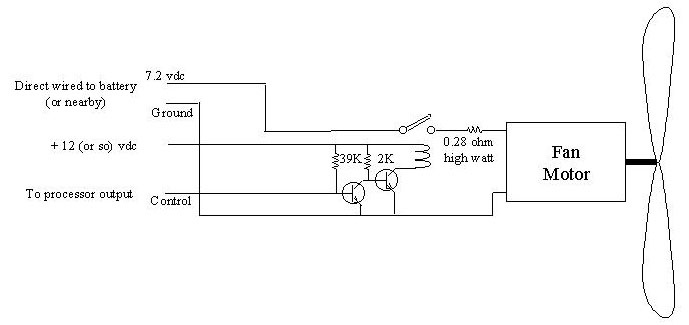
Monster Fan
If you've been to Trinity, you probably noticed that some fan howl and put out the flame immediately (even if not aimed accurately at it); and other fans would blow and you'd wonder if the candle would ever go out. This is one of the howlers.

Motor is a Graupner Speed 300. It is available from hobby stores for use on electric power model aircraft. It is rated for 6 Vdc. I ran it on a 7.2 volt battery. Propeller is from hobby store and made to fit this motor. This motor is very powerful (maybe especially on 7.2 v). Even using the proper propeller (which was just a press fit), the motor spun the prop loose after a while. I finally epoxied it on which did the trick.
This motor draws a lot of current. Depending on the propeller, it can get well over 10 amps. So you want a prop that is intended for it so it will spin at high RPM and hence keep the current down with back EMF. My first try was an oversize prop that made it pull 17 amps. The resistor in the drawing above is provisions to knock the current down a bit. I'm not using one with my final setup. If you use a resistor, watch out. It heats up rapidly.
I started out using a Radio Shack relay rated 10a @ 24vdc. After that relay failed, I went to an automotive relay which could handle 20 amps. The 12 volts supply shown above can be anything that can pull in the relay. I'm using 14.4 volts. The 7.2 volts and ground return should be direct wired to the low side battery with heavy gauge wiring (and a fuse would be nice).
Another thing to watch out for, originally I was trying to drive the motor with a 12 v 2.0Ah SLA battery. Even with a resistor inserted (slowing the fan down as much as I was willing to accept), the motor dragged down the battery voltage to 10 vdc or less...which kept my H Bridges (LMD18201) from working (they are spec'd at working down to 12 volts). So I went to 2 7.2 volt NiCad racing packs in series to supply the robot (14.4 vdc), and tapping off the low side battery to get 7.2 volts for the motor. Besides providing more voltage, the NiCads do not have as much of a voltage drop when supplying current as a similar size lead acid battery.
Transistors are 2N2222 since I had a bunch of them. The control signal is a standard 68HC912B32 output which sinks a max of 25 ma. Max current to sink here is 12vdc/39K = 0.3 ma.)
The forward biased base to emitter junction of the first transistor keeps the voltage back to the controller from exceeding 0.8 volts. If you’re concerned that a transistor failure may let 12 volts get to your processor and damage it, you could put a zener diode between the control signal and ground.
Two transistors are used, rather than just one, so that an active low is necessary to start the fan. Hence, resetting the processor doesn’t turn on the fan with a high on the control wire.
P.S. I'm not real fond of the relay implementation as my current relay is getting intermittant. A solid state switch might be a better idea. Although the turn on current of the motor might be pretty high initially. If and when I have a circuit together, I'll add it here.